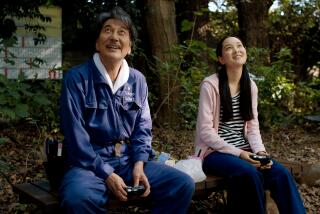MOVIE REVIEW : Deception in ‘Woman in the Dunes’
- Share via
In “Woman in the Dunes,” director Hiroshi Teshigahara raises sand to a major character--it seems to lie in wait, creeping up on the movie’s few characters, threatening to overtake them and the audience’s own sensibilities. It may be the only film that gets you thinking of a shower while reflecting on the symbolism at work.
Teshigahara’s ability to pull us into this creepily sensuous world, a stifling but beautiful environment, is what gives “Woman in the Dunes” such a disquieting feel. He accomplished what he set out to do--involve us in something alien.
Much of the credit goes to cinematographer Hiroshi Segawa, who infused this 1964 Japanese classic (screening at the Muckenthaler Cultural Center today) with an expressionistic style based on close-ups and romanticized sweeps over a dramatic landscape. Segawa’s black-and-white shots of the dunes contrast with the few people who inhabit this desolation--the camera lingers on the nude body of Kyoko Kishida, and her loveliness is echoed by the deceptively elegant surroundings Segawa settles on later.
“Woman in the Dunes” is a deceptive movie throughout. Part existential art film--a good example of the experimentation that marked an influential segment of Japanese filmmaking in the ‘60s--and part erotic psychological thriller, it follows the developing relationship between an entomologist (Eiji Okada) and a young woman (Kishida) who traps him with the help of anonymous villagers.
They keep this introspective scientist in a tomb-like shack at the bottom of a pit; he’s used as a laborer and later becomes her lover. She’s the sand beetle and he’s the insect that can’t escape--one of the film’s striking images finds Okada trying to climb out but, like a snared ant or a hapless Sisyphus, he can’t overcome the moving sand.
The scientist’s adjustment comes in deliberate steps, carefully, sometimes tediously, meted out by Segawa’s camera, as he begins to accept his situation. The urban complications of his home, Tokyo, start to blur, replaced by his understanding of this new life, which has brutalized but also simplified him.
Teshigahara doesn’t make this existential transition wholly believable, but he doesn’t have to. It’s not his intention, anyway. Okada is the human face of the allegory Teshigahara is offering on man’s uneasy relationship with nature, and the process by which we find a balance in a hostile environment. The scientist gives in to love, or at least loyalty to another person, and that changes him.
As for the mysterious young woman, she’s already gone down the long road the scientist is on. We learn that she’s been held for at least a year, accepting her fate by becoming an active participant. The woman still needs rejuvenation, though, which comes through the scientist, someone she can simply connect with sexually.
(Incidentally, “Woman in the Dunes” was a big controversy when it first came out more than 25 years ago, mainly because of the frankness of its sex scenes. It was a foolish protest; the movie is passionate, but pornographic is an adjective that doesn’t fit.)
The feelings that grow between them gives “Woman in the Dunes” its intrigue. Both Okada and Kishida avoid actorly indulgences, helping to keep the aura otherworldly and simple to the point of primitive.
At two hours, the tension sometimes slackens and the view can be too dense, a result of a focus that never retreats far from the dunes’ pressing quality and the monotony of small details that make up the pair’s lives. But Teshigahara’s direction and Segawa’s camera-work often render the mundane startling and new, a claim that only good films can make.
More to Read
Only good movies
Get the Indie Focus newsletter, Mark Olsen's weekly guide to the world of cinema.
You may occasionally receive promotional content from the Los Angeles Times.









